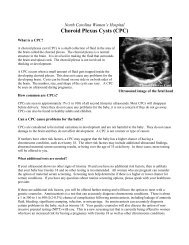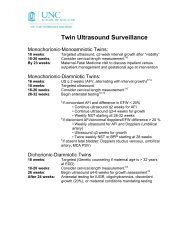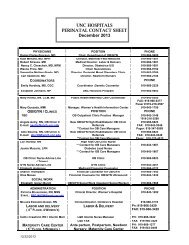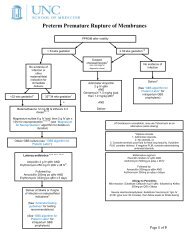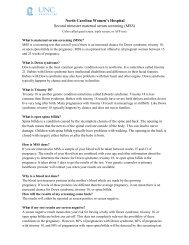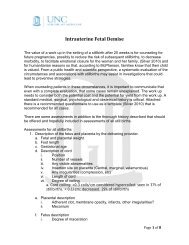Management of Diabetic Ketoacidosis in Pregnancy
Management of Diabetic Ketoacidosis in Pregnancy
Management of Diabetic Ketoacidosis in Pregnancy
Create successful ePaper yourself
Turn your PDF publications into a flip-book with our unique Google optimized e-Paper software.
<strong>Management</strong> <strong>of</strong> <strong>Diabetic</strong> <strong>Ketoacidosis</strong> <strong>in</strong> <strong>Pregnancy</strong>Check capillary glucose and serum/ur<strong>in</strong>e ketones to confirm hyperglycemia and ketonemia/ketonuria.Start IV fluids: 1.0 L <strong>of</strong> 0.9% NaCl per hour. Keep patient NPO.Use BETAMETHASONE WITH CAUTION and only with attend<strong>in</strong>g approval. AVOID Terbutal<strong>in</strong>e.Cont<strong>in</strong>uous fetal monitor<strong>in</strong>g until resolution <strong>of</strong> DKA as def<strong>in</strong>ed below.DKA alone is generally NOT an <strong>in</strong>dication for delivery. While fetal test<strong>in</strong>g may be abnormal dur<strong>in</strong>g acute DKA, fetal status should improve as the mother is treatedSTAT labs: Arterial blood gas, CBC with diff, ur<strong>in</strong>alysis, serum glucose, Na, Cl, K, HCO 3 , serum ketones, plasma osmolality, BUN, creat<strong>in</strong><strong>in</strong>e, andEKG. (Additional test<strong>in</strong>g to search for precipitat<strong>in</strong>g event should be <strong>in</strong>dividualized and may <strong>in</strong>clude: cultures <strong>of</strong> ur<strong>in</strong>e and blood, serum lipase, and CXR).IV Fluids(average fluid loss is 3-6 L)Determ<strong>in</strong>e hydration statusInsul<strong>in</strong> Potassium Assessneed forbicarbonateInsul<strong>in</strong>: Regular0.1 U/kg as IV bolusEstablish adequaterenal function (ur<strong>in</strong>eoutput ~50 ml/hr)SeverehypovolemiaAdm<strong>in</strong>ister 0.9%NaCl (1.0 L/hr)Sodium normal(135-145 mmol/L)or high (>145)0.45% NaCl(250-500 ml/hr)MildhypovolemiaCalculatecorrected*serum sodiumSodium low(5.3pH6.9-7.0pH>7.0NoHCODilute NaHCO 3 (50mmol) <strong>in</strong> 200 ml H 2 Owith 10 mEq KCL.Infuse over 1 hourIf pH 7.0.3Monitor serum K.When serum glucose reaches200 mg/dl, change to5% dextrose with 0.45% NaClat 150-250 ml/hr• Check electrolytes, BUN, venous pH, creat<strong>in</strong><strong>in</strong>e and glucose every 2-4 hrs until stable.• After resolution <strong>of</strong> DKA (see below) and when patient is able to eat, <strong>in</strong>itiate SC multidose <strong>in</strong>sul<strong>in</strong>regimen.• Cont<strong>in</strong>ue IV <strong>in</strong>sul<strong>in</strong> for 1-2 hr after SC <strong>in</strong>sul<strong>in</strong> begun to ensure adequate plasma <strong>in</strong>sul<strong>in</strong> levels.Cont<strong>in</strong>ue monitor<strong>in</strong>g on L&D for at least 2-4 hours after first SC <strong>in</strong>sul<strong>in</strong> dose.DKA diagnostic criteria: Serum glucose >250 mg/dl, Arterial pH
**Anion gap= (Na + K) – (Cl + HCO 3 )(all units mmol/L)ReferencesAdapted from UpToDate®. Kitabchi AE et al: Treatment <strong>of</strong> diabetic ketoacidosis and hyperosmolar hyperglycemicstate <strong>in</strong> adults. Accessed 11/03/2008.Cullen MT et al. Am J Per<strong>in</strong>atol 1996 Oct; 13(7): 449-51.Eleven episodes <strong>of</strong> DKA were diagnosed dur<strong>in</strong>g the 10-year study period. Plasma glucose levels <strong>of</strong> less than 200mg/dL were present <strong>in</strong> 4 <strong>of</strong> 11 patients (36%), 10 (90%) <strong>of</strong> whom presented with nausea, vomit<strong>in</strong>g, and decreasedcaloric <strong>in</strong>take.Approved 11-20-08Copyright November 2008UNC School <strong>of</strong> Medic<strong>in</strong>e






